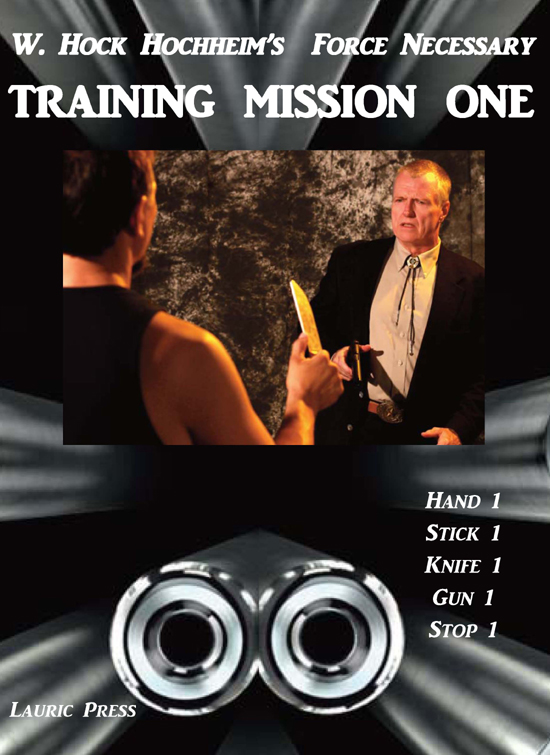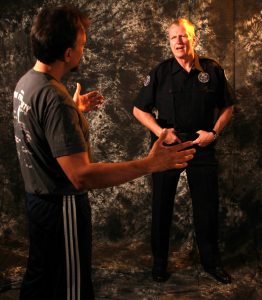Interview or ambush? You walk up to trouble, or trouble walks up to you! So, if it’s not a stone-cold, surprise, physical ambush, you are in a developing encounter-interview with someone who-
- is picking a fight with you for whatever the reason, yelling and arguing with you.
- is probably about to commit some sort of a crime upon you, other than simple assault.
The world is rage-full these days it seems. Even family, friends,acquaintances and strangers can twist off or…be criminals. You might still say the standoff-showdown is an “interview” of sorts. Just an interview? For professionals like police, guards, soldiers, etc. even if someone is screaming at your face, this is still an “interview,” and you have to somehow remain cool, calm and collect. This is professionalism at the best level. It’s hard. I know. It’s physically and mentally hard and situational.
Stay-Leave. When police, prosecutors and defense attorneys, virtually worldwide investigate a case, one major question they ask is – Why were you there? This is a two-parter, why did you go there and why are you still there? Were you stuck there for some reason?
If stuck there, how will you stand in front of, and-or around this cornering and-or aggressive person? We tackle this problem (pun intended) extensively in Stop 1 of the Stop 6 program – the 6 common “crash-collisions” of a fight. And Stop 1 of the 6 is nicknamed “Showdown,” or “Stand-Off,” a time just before contact…yet. In the hand, stick, knife and gun world, this zone is anything between sniper range on down to nearly nose-to-nose.
Since most of the population is not dealing with snipers, this brings us to the common “interview.” Thus, the “interview stance” must be some sort of a ready position. But not too, too “ready-looking” because that alone might psychologically escalate the situation, or cause any possible witnesses to think YOU were escalating the situation into law-breaking violence.
New Police interview Distance Advice. Of late, officers are advised to remain “two giant steps and a lunge” from a suspicious person. Of course, citizens are not required to stay and interview-talk, but some situations may cause them to remain. This sounds like a reasonable distance but an attacker can fly-spring right through that space. Keep that in mind.
A Quick Note on Verbal De-Escalators While on this initial confrontation topic, a quick “side step” here over to verbal skills. With all the verbal, de-escalator experts out there, there are many courses available on de-escalation. You will hear advice from all sorts of people.They are often run by lots of intellectual folks who have never had such attacks and confrontations forced on them, and they imagine, concoct, over-value their ideas that their great, practiced orations will interrupt a fight.
Remember that de-escalation for cops is different than for guards, different for door men, for soldiers, for citizens on a parking lot, family members in a domestic, angry customers, or road rage encounters, etc. Process their suggested advice through your Who, What, Where, When, How and Why Questions filter.
Not all advice helps you all the time. Never forget this guy drawn below who is just there to fight, All your non-aggressive, micro-expressions and rehearsed, non-aggressive wordings and steps won’t stop the guy who likes to fight on Friday night. And it’s getting late. He has his own negative script. He follows an antithesis to your script.
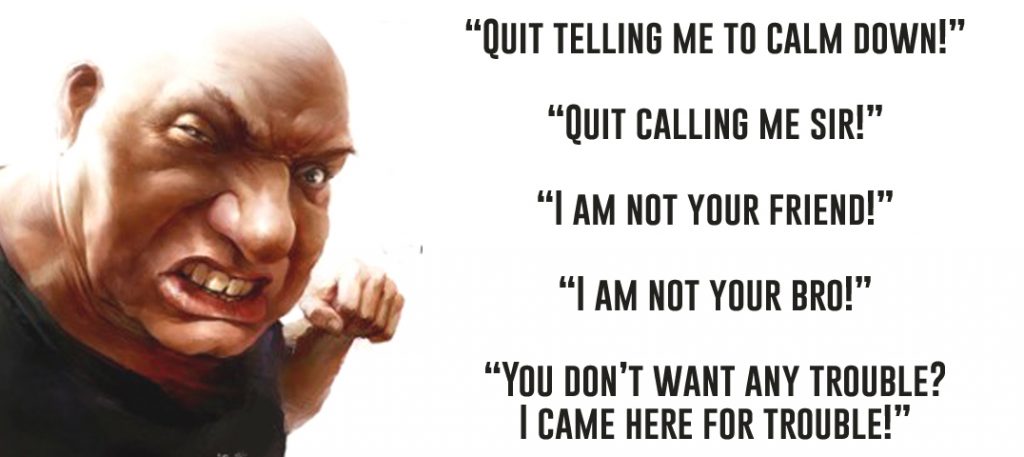
How Might You Stand? In this regard, I would like to say that in all my 3 decades of police work I had a trick in this pre-fight instance. If a situation was percolating into physical trouble, my body/feet would be bladed somewhat from that person, but not too far! Not like a sideways karate-kick stance! We’ll call it just somewhat “bladed.” Somewhat, which could be one foot an inch off the straight line. Simple walking creates bladed hip positions. It’s situational and positional. Just be athletic. Be football. Be rugby. Be basketball. And remember the phrase – a fighting stance is about balance and power in motion, not a still photograph.
In a potentially dangerous moment, I would, inside my pant’s legs, unbeknownst to anyone, bend slightly at the knees. This creates a more springboard, athletic position. It acted like a “switch” for me, turning on the “juices” in my body that trouble was brewing. I am sure by now you have heard the many experiments where body chemicals were sort of, inspired or reverse engineered in this manner. The same is true for other physical responses and body chemicals.
On the flip side of your concealed knee bend is his knee bend. If it’s visible? If you have a person confronting/standing before you, and he suddenly crouches down to some degree? This crouch is a natural athletic move and he might not realize he’s doing it. This is NOT good for you as it is a positive indication that he is about to get physical. A crouch and or they might start twisting their torso which is a high percentage, common precursor for a sucker punch, you must act according and prepare for trouble. (Inside my book Fightin’ Words and Training Mission One and my Stop 6 program, you will find all those pre-fight tips I’ve been collecting since 1973.) Remember all these cues when you must later articulate why you did what you did.
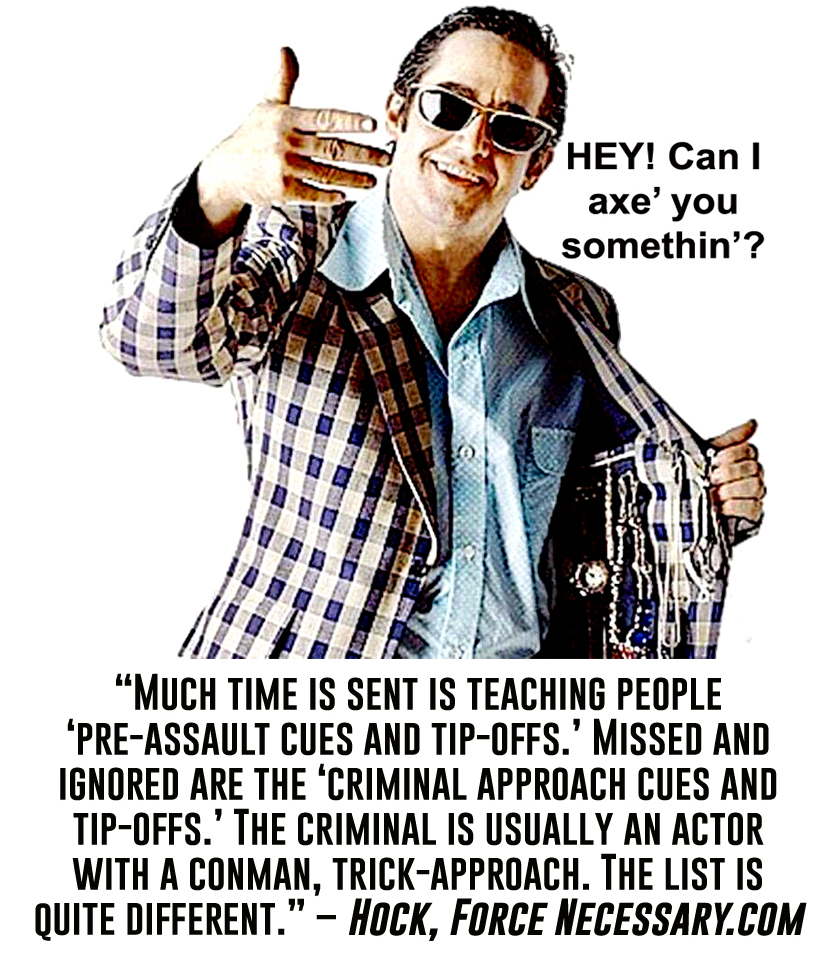
Pre-fight cues are different than pre-crime cues.
The Troubles with Pre-Emptive Stances and Strikes. But, if you jump into a fighting stance, “before” the actual fight, which might be a terrific idea, be aware that your “action-guy” pose could be perceived as an escalation to violence. This may spur on the other guy, or make YOU look like the actual fight-starter to ignorant witnesses –
“Two guys were just arguing, Officer. And then, the guy in the suit squared off like he was going to fight. Then the other guy did too. Then the fight started.”
You inadvertently “started” the fight by just getting ready to fight. What if you struck first to protect yourself from an inevitable assault? Part of many self defense repertoires is the “re-emptive” strike, taught void of legal traps and complications. I mean, such strikes are smart and great in many ways. You know this physical fight is going to happen, so you strike first. This is your own little ambush to thwart his plan. Best are usually delivered from a non-fighting, “sucker punch stance, huh? Could be a strike or a kick. This is why all unarmed, self defense systems must practice all their strikes and kicks from the typical, neutral, non-fight stances. But, this same witnessing of a pre-emptive strike can make you look like the law-breaking, “fight-starter.” Nearby witnesses may tattle:
“Two guys were just arguing, officer, and then the guy on the left hauled off and smacked the other guy in the head!”
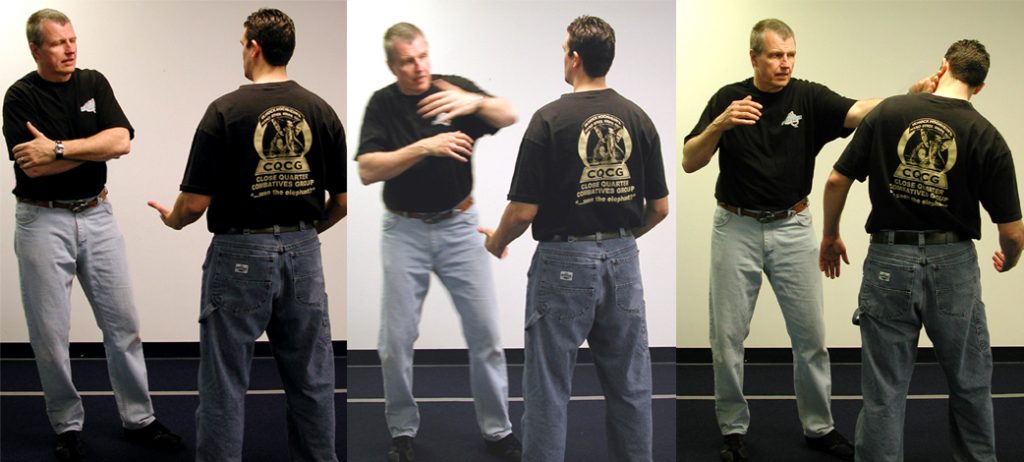
Like so much in life, anything within a certain spectrum of events, good or bad, can happen. May work. May not work. In this particular “stand-off, heated interview” moment, here are some common, even natural responses in the script of life.
- Leaving, fast or slowly in an “orderly retreat.”
- Cowering, “collapsing” of some facial and physical sort.
- Automatic anger.
- Ignoring the confronter, in some way.
- Command presence of some sort.
- Fighting ready pose.
- Maneuver a distance from the problem person or persons (see below on distances).
- Sometimes you can just keep walking.
- Get something between you. Car? Table? Whatever? Be aware of the “stuff” all around you.
- Maneuver near an exit, for a sudden escape.
- Maneuver over into the sight of witnesses.
- Maneuver to something that can be grabbed as a weapon or a shield.
- Realize a person or persons may be maneuvering YOU by crowding you, distracting you and getting you into a inescapable position, a no-witness situation. (A pre-meditated ambush is full of these factors.)
- Running away? How far and fast can you run?
- Keep developing this list…
********
Hock’s email is Hock@SurvivalCentrix.com
These interview-ambush subjects are covered EXTENSIVELY in Training Mission One book, click here
